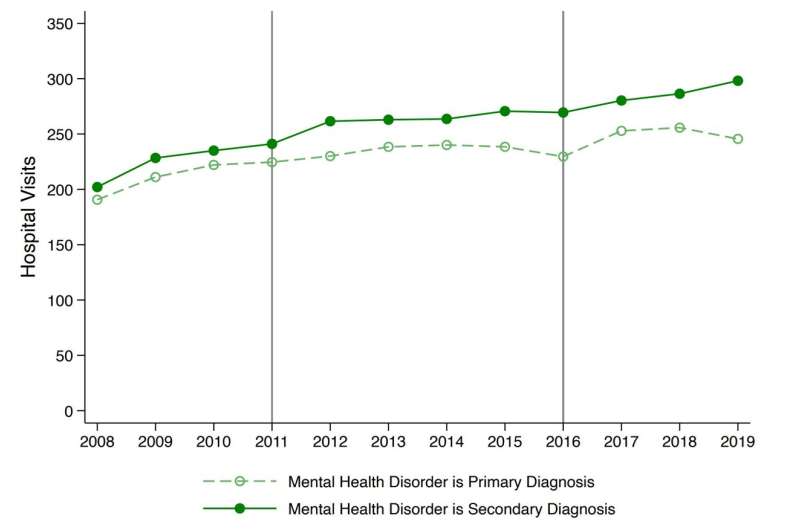This article has been reviewed according to Science X's editorial process and policies. Editors have highlighted the following attributes while ensuring the content's credibility:
fact-checked
peer-reviewed publication
trusted source
proofread
Study sheds light on increased reports of suicidal behavior in teens

Reports of increasing suicidal behaviors in children in the decade leading up to the COVID pandemic suggest there was already a mental health crisis among teens and children. However, a new analysis of data from one state suggests some of this increase is due to changes in how health professionals screen for and report on suicidal thoughts or ideas in young people.
"One reason we did this study was to better understand what was happening with regard to the reported increase in suicidal behavior among young people," says Adriana Corredor-Waldron, co-author of the new study and an assistant professor of economics in North Carolina State University's Poole College of Management.
"We believe there is a mental health crisis among children, and that the rate of suicide-related behaviors is high," Corredor-Waldron says.
"However, in New Jersey, which is the state we focused on, the rate of hospital visits for self-harm and suicide attempts changed very little over the 12 years we studied. Instead, there was a significant increase in children and teens diagnosed with suicidal ideation—having suicidal thoughts. And this increase in diagnoses of suicidal ideation was associated with changes in how health care providers screen for and report these behaviors."
"Hence, the study really stresses how important it is to dig into the details of what is driving reported health trends," Corredor-Waldron says. "This steep trend of increasing suicidal behaviors may actually reflect the fact that we are doing a better job of identifying young people who need treatment. That would be good news."
For the study, the researchers looked at data on all hospital visits of children ages 10-18 in New Jersey from 2008 through 2019.
When looking at all suicide-related visits, there was a general upward trend over the 12-year period. However, the researchers found that the trend was driven almost entirely by an increase in diagnoses in suicidal ideation. And the timing of those increased diagnoses was related to two factors: revised screening recommendations and changes in the "coding" of suicidal ideation.
The screening recommendations refer to guidelines published in 2011 by the U.S. Department of Health and Human Services which encouraged health care providers to conduct annual depression screening of girls and women aged 12 and older.
Coding refers to the standardized system health care providers use to record the diagnoses of patients. This coding data can be used to identify health trends. In late 2016, new coding regulations went into effect that required providers to enter a code for suicidal ideation whenever it presented as a patient's symptom—even if the primary diagnosis for the patient was a mood disorder.
"For example, prior to 2016, if a patient had suicidal ideation and was diagnosed with depression, a health care provider would likely have entered only the medical code for depression," Corredor-Waldron says. "After 2016, providers would enter codes for both depression and suicidal ideation."
The researchers found a significant increase in reporting of suicidal ideation after the new screening recommendations went into effect in 2011. But there was an even more dramatic increase in reporting of suicidal ideation after the new coding regulations were implemented in 2016.
"It's important to note that this data is from one state, and every state is different," says Corredor-Waldron. "Also, we don't have this level of data for the time period of the COVID pandemic yet, and it would be good to see how things might have changed over the past few years."
The paper, "To What Extent Are Trends in Teen Mental Health Driven By Changes in Reporting? The Example of Suicide-Related Hospital Visits," is published in the Journal of Human Resources.
More information: Adriana Corredor-Waldron et al, To What Extent are Trends in Teen Mental Health Driven by Changes in Reporting?, Journal of Human Resources (2023). DOI: 10.3368/jhr.0423-12854R1



















